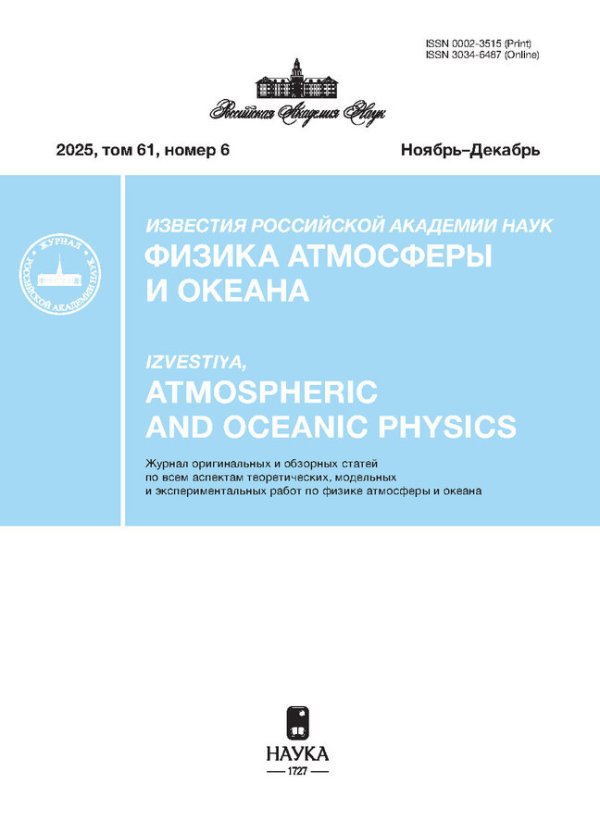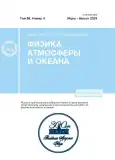Integration of Satellite Monitoring and Mathematical Modeling in the Analysis of the Nature of Elevated Sulfur Dioxide Concentrations in the Surface Air of the Northern Part of Finland
- Authors: Dryukova E.D.1, Nerobelov G.M.2,3, Sedeeva M.S.2, Kiselev A.V.2, Mahura A.G.4, Gorny V.I.2
-
Affiliations:
- Russian State Hydrometeorological University
- SPC RAS - Scientific Research Centre for Ecological Safety, Russian Academy of Sciences
- Saint-Petersburg State University
- University of Helsinki, Institute for Atmospheric and Earth System Research (INAR)/Physics, Faculty of Science, Kumpula campus
- Issue: Vol 59, No 4 (2023)
- Pages: 450-460
- Section: Articles
- URL: https://journals.rcsi.science/0002-3515/article/view/136932
- DOI: https://doi.org/10.31857/S0002351523040041
- EDN: https://elibrary.ru/YMZGRK
- ID: 136932
Cite item
Full Text
Abstract
The article is devoted to the investigation of the nature of the increment in surface concentration of toxic gas sulfur dioxide (SO2) in Northern Finland. The study is carried out for June 2011 when the increased near-surface SO2 concentration was registered at Finnish observation station Inari Raja-Jooseppi together with the surface wind blowing from the territory of the Kola Peninsula. The hypothesis of natural increment of near-surface SO2 concentration as a result of Grímsvötn volcano eruption (Iceland) is verified using satellite SO2 observations by OMI, numerical weather prediction and atmospheric chemistry model Enviro-HIRLAM and particle dispersion model HYSPLIT. The results show that not only local man-made sources, but also the remote transfer of pollutants from volcanic eruptions can cause an increased near-surface SO2 concentration. To verify this hypothesis, a large set of statistics is required in Northern Finland during periods of volcanic activity in Iceland.
About the authors
E. D. Dryukova
Russian State Hydrometeorological University
Email: akulishe95@mail.ru
Russia, 195196, Saint-Petersburg, Malookhtinskiy Prospekt, 98
G. M. Nerobelov
SPC RAS - Scientific Research Centre for Ecological Safety, Russian Academy of Sciences; Saint-Petersburg State University
Author for correspondence.
Email: akulishe95@mail.ru
Russia, 187110, Saint-Petersburg, Korpusnaya st., 18; Russia, 199034, Saint-Petersburg, University Embankment, 7/9
M. S. Sedeeva
SPC RAS - Scientific Research Centre for Ecological Safety, Russian Academy of Sciences
Email: akulishe95@mail.ru
Russia, 187110, Saint-Petersburg, Korpusnaya st., 18
A. V. Kiselev
SPC RAS - Scientific Research Centre for Ecological Safety, Russian Academy of Sciences
Email: akulishe95@mail.ru
Russia, 187110, Saint-Petersburg, Korpusnaya st., 18
A. G. Mahura
University of Helsinki, Institute for Atmospheric and Earth System Research (INAR)/Physics, Faculty of Science,Kumpula campus
Email: akulishe95@mail.ru
Finland, FI-00560, Helsinki, Gustaf Hallstrominkatu 2a
V. I. Gorny
SPC RAS - Scientific Research Centre for Ecological Safety, Russian Academy of Sciences
Email: akulishe95@mail.ru
Russia, 187110, Saint-Petersburg, Korpusnaya st., 18
References
- Акимов В. С. Диоксид серы и основные источники загрязнения атмосферы диоксидом серы // Научный журн. 2017. № 6-1(19). С. 18–20.
- Министерство природных ресурсов, экологии и рыбного хозяйства Мурманской области. Доклад о состоянии и об охране окружающей среды Мурманской области за 2018 г. // 2019 г. https://mpr.gov-murman. ru/activities/napravleniya/okhrana-okruzhayushchey-sredy/ 00.condition/index.php (дата обращения 20.06.22).
- Неробелов Г.М., Седеева М.С., Махура А.Г., Нутерман Р.Б., Смышляев С.П. Enviro-HIRLAM моделирование переноса атмосферных загрязнителей и воздействия аэрозолей на метеорологические параметры над северо-западной частью России и Северной Европой // Материалы всероссийской научной конференции с международным участием “Земля и космос” к столетию академика РАН К.Я. Кондратьева. 20–21 октября 2020 года, Санкт-Петербург. Сборник статей. СПб.: 2020. 334 с.
- Каролин С. Программа “Пасвик” – общий отчет 2008 // 2008. http://www.pasvikmonitoring.org/pdf/Pasvikprogrammet_summary_rus_.pdf.
- Спахова А.С., Рязанцева Л.А. Повреждаемость некоторых древесных растений сернистым газом // Физиология растений. 1978. Т. 25. № 2. С. 407–409.
- Шлегель К.Д., Верхотуров С.С. Токсикологические свойства газообразных загрязнений и их влияние на организм человека // Актуальные проблемы авиации и космонавтики. 2016. № 12. С. 946–948.
- Andreae M.O. et al. Vertical distribution of dimethylsulfide, sulfur dioxide, aerosol ions, and radon over the northeast Pacific Ocean // J. Atmospheric Chemistry. 1988. T. 6. № 1. C. 149–173.
- Baklanov A. et al. Enviro-HIRLAM online integrated meteorology–chemistry modelling system: strategy, methodology, developments and applications (v7.2) // Geoscientific Model Development. 2017. T. 10. № 8. C. 2971–2999. https://doi.org/10.5194/gmd-10-2971-2017
- Beirle S., Hörmann C., Penning de Vries M., Dörner S., Kern C., Wagner T. Estimating the volcanic emission rate and atmospheric lifetime of SO2 from space: a case study for Kīlauea volcano, Hawai`I // Atmos. Chem. Phys. 2014. 14. P. 8309–8322. https://doi.org/, 2014.https://doi.org/10.5194/acp-14-8309-2014
- Fioletov V.E., McLinden C.A., Krotkov N., Li C., Joiner J., Theys N., Carn S., Moran M.D. A global catalogue of large SO2 sources and emissions derived from the Ozone Monitoring Instrument. // Atmos. Chem. Phys. 2016. V. 16. P. 11497–11519. https://doi.org/10.5194/acp-16-11497-2016
- Fuentes García G., Echeverría R.S., Reynoso A.G., Baldasano Recio J.M., Rueda V.M., Retama Hernández A., Kahl J.D.W. Sea Port SO2 Atmospheric Emissions Influence on Air Quality and Exposure at Veracruz, Mexico // Atmosphere. 2022. V. 13. 1950. https://doi.org/10.3390/atmos13121950
- Gudmundsson M.T., Höskuldsson Á., Larsen G., Thordarson T., Oladottir B.A., Oddsson B., Gudnason J., Högnadottir T., Stevenson J.A., Houghton B.F., McGarvie D., Sigurdardottir G.M. The May 2011 eruption of Grímsvötn // EGU 2012. https://meetingorganizer.copernicus.org/ EGU2012/EGU2012-12119.pdf.
- Hirdman D., Sodemann H., Eckhardt S., Burkhart J.F., Jefferson A., Mefford T., Quinn P.K., Sharma S., Strm J., Stohl A. // Source identification of short-lived air pollutants in the Arctic using statistical analysis of measurement data and particle dispersion model output, Atmos. Chem. Phys. 2010. V. 10. 669693. https://doi.org/10.5194/acp-10-669-2010
- Jaffe D. et al. Transport of Asian air pollution to North America //G eophysical Research Letters. 1999. T. 26. № 6. P. 711–714.
- Khokhar M.F., Frankenberg C., Van Roozendael M., Beirle S., Kuhl S., Richter A. et al. Satellite observations of atmospheric SO2 from volcanic eruptions during the time-period of 1996 20 02. Adv. Space Res. 2005. V. 36. 879887.
- Kyrö E.-M., Väänänen R., Kerminen V.-M., Virkkula A., Petäjä T., Asmi A., Dal Maso M., Nieminen T., Juhola S., Shcherbinin A., Riipinen I., Lehtipalo K., Keronen P., Aalto P.P., Hari P., Kulmala M. Trends in new particle formation in eastern Lapland, Finland: effect of decreasing sulfur emissions from Kola Peninsula // Atmos. Chem. Phys. 2014. V. 14. P. 4383–4396. https://doi.org/, 2014.https://doi.org/10.5194/acp-14-4383-2014
- Lamotte C., Guth J., Marécal V., Cussac M., Hamer P.D., Theys N., Schneider P. Modeling study of the impact of SO2 volcanic passive emissions on the tropospheric sulfur budget // Atmos. Chem. Phys. 2021. V. 21. P. 11 379–11 404. https://doi.org/10.5194/acp-21-11379-2021
- Lee C., Martin R.V., van Donkelaar A., Lee H., Dickerson R.R., Hains J.C., Krotkov N., Richter A., Vinnikov K., Schwab J.J. SO2 emissions and lifetimes: Estimates from inverse modeling using in situ and global, space-based (SCIAMACHY and OMI) observations // J. Geophys. Res. 2011. V. 116. D06304. https://doi.org/10.1029/2010JD014758
- Li C., Krotkov N.A., Leonard P. OMI/Aura Sulfur Dioxide (SO2) Total Column L3 1 day Best Pixel in 0.25 degree x0.25 degree V3, Greenbelt, MD, USA, Goddard Earth Sciences Data and Information Services Center (GES DISC). 2020. Accessed: 2022-10-01. https://doi.org/0.5067/Aura/OMI/DATA3008
- Mahura A., Gonzalez-Aparacio I., Nuterman R., Baklanov A. Seasonal Impact Analysis On Population Due To Continuous Sulphur Emissions From Severonikel Smelters Of The Kola Peninsula // Geography, Environment, Sustainability. 2018. V. 11. № 1. P. 130–144.https://doi.org/10.24057/2071-9388-2018-11-1-130-144
- Paez P.A., Cogliati M.G., Caselli A.T., Monasterio A.M. An analysis of volcanic SO2 and ash emissions from Copahue volcano // J. South American Earth Sciences. 2021. V. 110. 103365.
- Seinfeld J.H., Pandis S.N. Atmospheric chemistry and physics: From air pollution to climate change. 1998. p. 1326.
- Sipilä M., Sarnela N., Neitola K., Laitinen T., Kemppainen D., Beck L., Duplissy E.-M., Kuittinen S., Lehmusjärvi T., Lampilahti J., Kerminen V.-M., Lehtipalo K., Aalto P.P., Keronen P., Siivola E., Rantala P.A., Worsnop D.R., Kulmala M., Jokinen T., Petäjä T. Wintertime subarctic new particle formation from Kola Peninsula sulfur emissions // Atmos. Chem. Phys. 2021. V. 21. P. 17 559–17 576. https://doi.org/10.5194/acp-21-17559-2021
- Sportisse B. Fundamentals in Air Pollution – From Processes to Modelling // Springer Dordrecht. 2009. р. 299.
- Stein A.F., Draxler R.R., Rolph G.D., Stunder B.J.B., Cohen M.D., Ngan F. NOAA’s HYSPLIT Atmospheric Transport and Dispersion Modeling System // Bull. American Meteorological Society. 2015. V. 96. № 12. P. 2059–2077. https://doi.org/10.1175/BAMS-D-14-00110.1
- Tu F.H. et al. Long-range transport of sulfur dioxide in the central Pacific // J. Geophysical Research: Atmospheres. 2004. T. 109. № D15.
- Wallace J.M., Hobbs P.V. Atmospheric science: an introductory survey. // Elsevier Academic Press: Amsterdam, The Netherlands. 2006. T. 92.
- World Health Organization. Regional Office for Europe. Air quality guidelines: global update 2005: particulate matter, ozone, nitrogen dioxide and sulfur dioxide // World Health Organization. Regional Office for Europe. 2006. P. 484. https://apps.who.int/iris/handle/10665/107823.
Supplementary files















